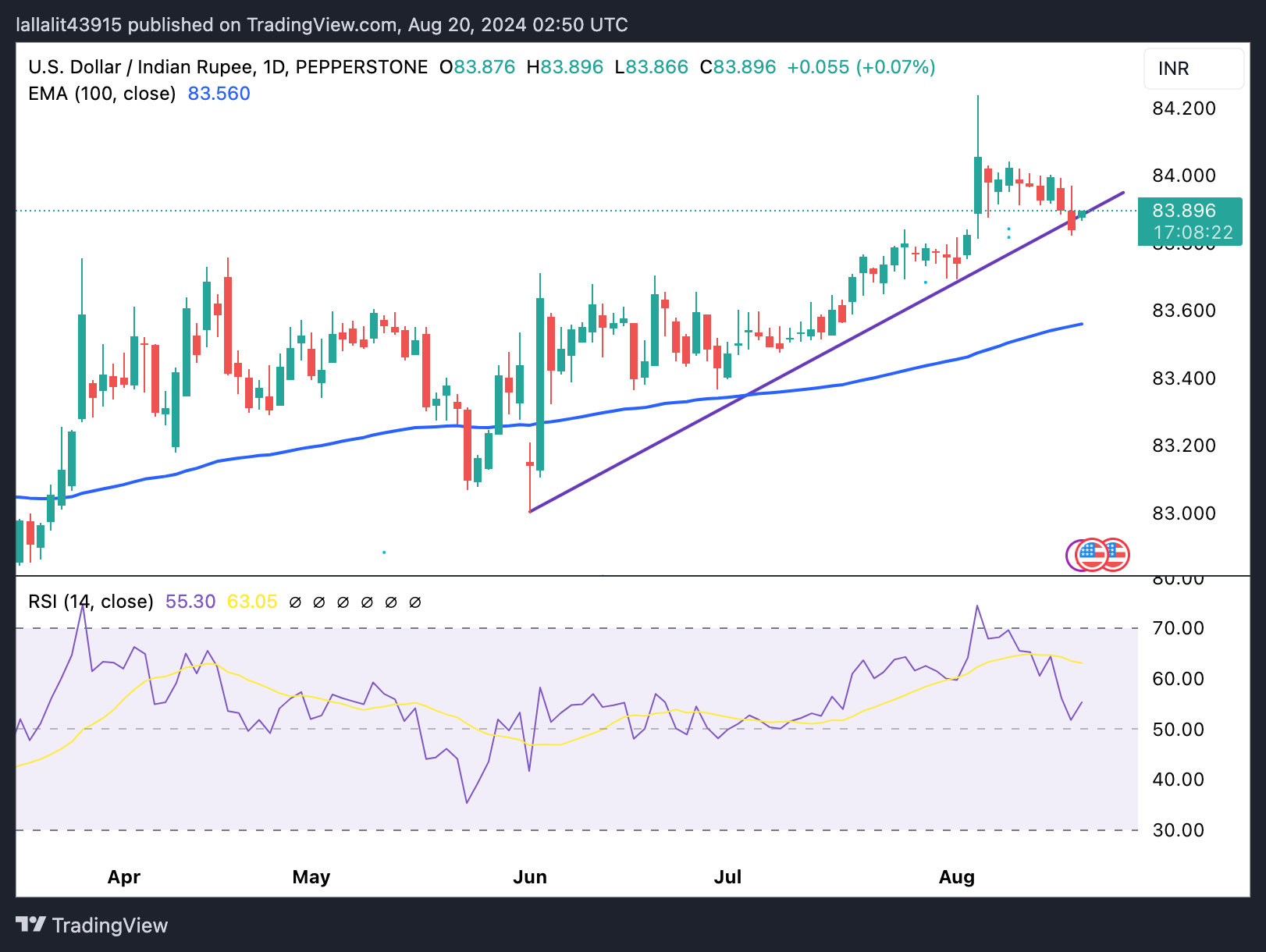USD/INR struggles to gain ground on the softer US Dollar, investors await Fedspeak

- The Indian Rupee holds steady near two-week highs in Tuesday’s early Asian session.
- Weaker Greenback and lower crude oil prices support the INR; renewed USD demand and Indian outflows might cap its upside.
- Investors will watch the Fed’s Raphael Bostic and Michael Barr speeches on Tuesday.
The Indian Rupee (INR) trades flat on Tuesday. The further decline of the US Dollar (USD) has boosted Asian currencies and lifted the INR to its highest in two weeks. Additionally, the fall in crude oil prices is likely to underpin the local currency as India is one of the largest importers of crude oil.
On the other hand, the renewed USD demand from public sector banks and outflows from local equities might cap the INR’s gains. Investors will focus on the Fed’s Raphael Bostic and Michael Barr speeches on Tuesday. The highlight will be Fed Chair Jerome Powell’s speech on Friday, which might provide some outlook about the path forward for US interest rates. On the Indian docket, the first reading of the HSBC Purchasing Managers Index (PMI) for August will be released on Wednesday.
Daily Digest Market Movers: Indian Rupee recovers some lost ground on the softer USD
- “A large public sector bank started buying (Dollars) when the currency touched 83.85/$1 and there is a good possibility that the PSU bank may be buying on behalf of the central bank, as the RBI may not be comfortable with the upside in Rupee”, said Anil Bhansali, Head of Treasury at Finrex Treasury Advisors LLP.
- The Deputy Managing Director of the International Monetary Fund (IMF), Dr. Gita Gopinath, said that she is hopeful of India becoming the third-largest economy by 2027 as the growth did much better than expected during the last fiscal year and that those carryover effects are affecting our forecast for this year.
- The RBI noted demand conditions in the Indian economy are gathering momentum, adding that the decline of inflation pressures has pushed rural spending and driven a catch-up with urban consumption volumes, according to the RBI monthly bulletin of August 2024.
- India’s exports fell 6% in the current fiscal year through July compared to the same period in the previous year. In FY24, foreign direct investment in India decreased by 3.5%. Foreign portfolio investors (FPI) have withdrawn cash funds from India owing to the country’s overheated stock market.
- Federal Reserve Bank of Minneapolis President Neel Kashkari said on Monday that he would be open to cutting US interest rates in September because of the rising possibility that the labor market weakens too much.
Technical analysis: USD/INR resumes downside journey
Indian Rupee trades on a flat note on the day. The bullish outlook of the USD/INR pair seems vulnerable as the pair is testing the 11-week-old uptrend line on the daily timeframe. A daily close below the ascending support could lead to a drop towards the 100-day Exponential Moving Average (EMA). Nonetheless, the 14-day Relative Strength Index (RSI) stands above the midline near 54.0, indicating the upward momentum remains in place.
If the pair decisively closes below the uptrend line at 83.90, it will signal the downtrend of USD/INR. The next downside stops to watch are the 100-day EMA at 83.56, followed by 83.36, the low of June 28.
On the upside, the 84.00 psychological barrier acts as a key resistance level for the pair. Extended gains above this level could pave the way to the all-time high of 84.24, followed by 84.50. 
US Dollar price today
The table below shows the percentage change of US Dollar (USD) against listed major currencies today. US Dollar was the weakest against the Swiss Franc.
| USD | EUR | GBP | CAD | AUD | JPY | NZD | CHF | |
| USD | 0.07% | 0.08% | 0.04% | 0.22% | 0.18% | 0.06% | -0.06% | |
| EUR | -0.09% | 0.00% | -0.05% | 0.13% | 0.10% | -0.05% | -0.15% | |
| GBP | -0.08% | 0.00% | -0.05% | 0.13% | 0.10% | -0.02% | -0.15% | |
| CAD | -0.04% | 0.04% | 0.04% | 0.18% | 0.14% | 0.00% | -0.11% | |
| AUD | -0.22% | -0.12% | -0.13% | -0.18% | -0.04% | -0.16% | -0.26% | |
| JPY | -0.17% | -0.11% | -0.09% | -0.15% | 0.02% | -0.12% | -0.25% | |
| NZD | -0.04% | 0.05% | 0.03% | -0.01% | 0.18% | 0.13% | -0.12% | |
| CHF | 0.09% | 0.12% | 0.15% | 0.11% | 0.28% | 0.25% | 0.13% |
The heat map shows percentage changes of major currencies against each other. The base currency is picked from the left column, while the quote currency is picked from the top row. For example, if you pick the Euro from the left column and move along the horizontal line to the Japanese Yen, the percentage change displayed in the box will represent EUR (base)/JPY (quote).
Indian Rupee FAQs
The Indian Rupee (INR) is one of the most sensitive currencies to external factors. The price of Crude Oil (the country is highly dependent on imported Oil), the value of the US Dollar – most trade is conducted in USD – and the level of foreign investment, are all influential. Direct intervention by the Reserve Bank of India (RBI) in FX markets to keep the exchange rate stable, as well as the level of interest rates set by the RBI, are further major influencing factors on the Rupee.
The Reserve Bank of India (RBI) actively intervenes in forex markets to maintain a stable exchange rate, to help facilitate trade. In addition, the RBI tries to maintain the inflation rate at its 4% target by adjusting interest rates. Higher interest rates usually strengthen the Rupee. This is due to the role of the ‘carry trade’ in which investors borrow in countries with lower interest rates so as to place their money in countries’ offering relatively higher interest rates and profit from the difference.
Macroeconomic factors that influence the value of the Rupee include inflation, interest rates, the economic growth rate (GDP), the balance of trade, and inflows from foreign investment. A higher growth rate can lead to more overseas investment, pushing up demand for the Rupee. A less negative balance of trade will eventually lead to a stronger Rupee. Higher interest rates, especially real rates (interest rates less inflation) are also positive for the Rupee. A risk-on environment can lead to greater inflows of Foreign Direct and Indirect Investment (FDI and FII), which also benefit the Rupee.
Higher inflation, particularly, if it is comparatively higher than India’s peers, is generally negative for the currency as it reflects devaluation through oversupply. Inflation also increases the cost of exports, leading to more Rupees being sold to purchase foreign imports, which is Rupee-negative. At the same time, higher inflation usually leads to the Reserve Bank of India (RBI) raising interest rates and this can be positive for the Rupee, due to increased demand from international investors. The opposite effect is true of lower inflation.
Source link





